There’s an awful lot of articles about antimatter and mystery. For example there’s a 2017 Symmetry magazine article matter-antimatter mystery remains unsolved. It’s about the BASE experiment at CERN where they’ve measured the antiproton magnetic moment. Surprise surprise, it’s the exact opposite of the proton magnetic moment. Then there’s the LiveScience article mystery deepens: matter and antimatter are mirror images. Of course they are, the positron has the opposite chirality to the electron. And then there’s the CERN courier article does antimatter fall up? No it does not.
Antimatter does not fall up
Anybody who knows anything about relativity knows why antimatter doesn’t fall up. It’s because the mass of a body is a measure of its energy content, as per Einstein’s E=mc² paper:

Note how Einstein referred to a body and the electron on the same line? The mass of an electron is a measure of its energy-content. Hence when you trap a massless photon in a gedanken mirror-box, the mass the system is increased. When a photon is propagating linearly through space we call its resistance to change-in-motion energy or momentum or energy-momentum. When the photon is going around and around inside the box we call its resistance to change-in-motion mass. This is relevant to the electron because of the wave nature of matter and because the electron’s spin is real, as evidenced by the Einstein-de Haas effect. Hence you can liken an electron to a 511 keV photon going around and around in a box of its own making. It’s the same for a positron, but since the positron has the opposite chirality, you can liken it to a photon going around and around the other way. So if you have three gedanken boxes, one containing a 511 keV photon, one containing a 511 keV electron, and one containing a 511 keV positron, they all have the same mass. That mass is positive in all cases. There are no things with a negative mass, just as there are no pencils less than zero inches long. Hence there is no runaway motion comprised of “a push that repels the positive mass from the negative mass, and a pull that attracts the negative mass”. It’s all pull. In Newtonian terms the gravitational force between two masses is F = G m1m2 / r². The force pulls the masses towards one another. It doesn’t push them apart. So when you let go of your boxes, the box containing the positron doesn’t hit the ceiling. They all fall down.
Why antimatter falls down
As to why, not everybody who knows about relativity can tell you how gravity works, but it’s fairly straightforward. A gravitational field is a place where a concentration of energy in the guise of a massive planet or star “conditions” the surrounding space, this effect diminishing with distance in a non-linear fashion. It’s described using the stress-energy-momentum tensor, but note that stress is directional pressure, so in a way space is pressed outwards. As a result space is inhomogeneous, and light curves down like sonar waves curve down, because the speed of light is not constant, instead it’s spatially variable. When you then apply the wave nature of matter and the other evidence, you can think of an electron as light going around and around, like the photon in a box of its own making. Then you can simplify the electron to light going around a square path. Try drawing it. Make the horizontals curve downwards a little. Without lifting your pen from the paper, draw it again, and again. You soon get the gist of why an electron falls down. Ditto for the positron, which is like light going around and around the other way. In a gravitational field the horizontal components curve downwards, regardless of which way around the light is going. So the electron falls down, and the positron falls down too:
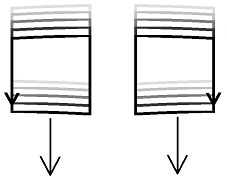
The reducing speed of light is transformed into the downward motion of the electron or positron, and internal kinetic energy or mass-energy is converted into external kinetic energy. The latter tends to get radiated away, resulting in a mass deficit. But note that only the horizontal component bends down, so the Newtonian deflection of matter is only half the deflection of light. And since you can diffract not just electrons and positrons but protons and antiprotons and neutrons too, the same principle applies to all matter and antimatter.
Antimatter is commoner than you think
I should mention that antimatter is commoner than you might think. Most people in the UK live fairly close to a major hospital. The same is true in large parts of Europe, Asia, and the USA. And in that major hospital, the chances are there’ll be a PET scanner. This typically incorporates fluorine-18 which undergoes β+ or beta-plus decay aka positron emission, emitting a positron and an electron neutrino and turning into oxygen-18. Positrons are also associated with thunderstorms. See NASA’s Fermi catches thunderstorms hurling antimatter into space. Or google on sprite thunderstorm positron and check out terrestrial gamma flashes aka TGFs. If it’s not raining and you’re not at forty thousand feet, there’s still positrons around, produced by cosmic rays. That’s how Carl Anderson discovered them. Mind you, he went up Pike’s Peak, which is over fourteen thousand feet. So if you’re looking for something closer to home, take a look in your fruit bowl. Also take a look at the Symmetry article antimatter from bananas. Flip Tanedo says this: “While researching natural sources of antimatter, I discovered a curious article about a naturally occurring potassium isotope that, some fraction of the time, decays via positron emission. The conclusion was that: The average banana (rich in potassium) produces a positron roughly once every 75 minutes”. Flip is really into antimatter, see his quantum diaries article helicity chirality mass and the Higgs. But note that like Flip, a positron does not have a moustache. What it does have, is the opposite chirality to the electron:
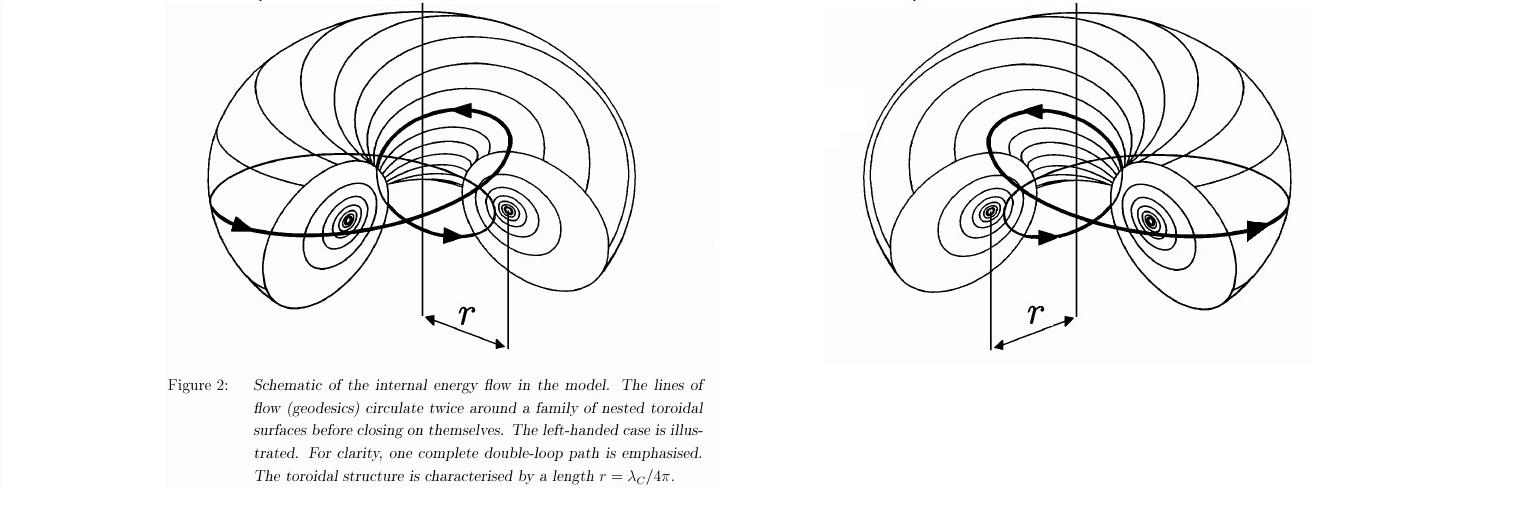 Leftside image by of John Williamson and Martin van der Mark, rightside image created from the leftside image by me
Leftside image by of John Williamson and Martin van der Mark, rightside image created from the leftside image by me
It’s not entirely unlike enantiomers, where we have L-glucose and D-glucose aka dextrose. Or it’s like the way a Möbius strip can twist clockwise or anticlockwise – note the Möbius strip in the Wikipedia spinor article. Or if you prefer, it’s like the way two knots can have the opposite chirality: you can tie your shoelaces left-over-right or right-over-left. Note though that the positron isn’t quite a mirror-image of the electron. You can play around with gifs to appreciate this. You can do a flip horizontal, but it isn’t quite enough. You also have to reverse the gif. You play it backwards:
xxx xxxxxxxxxx xxxxxxxxxxxxxxxx
xxxxxxxxxxxxxxxx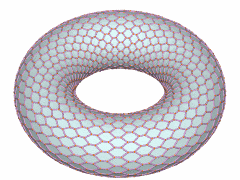
Gifs by Adrian Rossiter, see his torus animations
In this sense the positron is a mirror-image time-reversed electron. Note that it isn’t time-reversed because it’s an electron travelling back in time, as per Wheeler’s one-electron universe. Also note that the electron isn’t actually a doughnut, and nor is a positron. The Williamson / van der Mark image features “onion rings” in the sectional slices. You need to keep adding bigger and bigger rings until you inflate the torus to near-spherical symmetry, see Adrian Rossiter’s torus animations. Then you have to keep on going, because the electron doesn’t have a surface. In similar vein it isn’t some thing that “has” a field. Field is what it is. It’s a “standing-wave field construct”, and so is the positron.
Matter and antimatter in the early universe
Of course, people do say antimatter is very uncommon compared to ordinary matter. They also say it didn’t used to be, and then they wonder where it all went. The CERN webpage on the matter-antimatter asymmetry problem is fairly typical of that. It says the Big Bang should have created equal amounts of matter and antimatter, but everything we see today is made almost entirely of matter. It goes on to say “something must have happened to tip the balance. One of the greatest challenges in physics is to figure out what happened to the antimatter”. I’d say most physicists would concur with that sentiment. The general idea is that the early universe was a white-hot seething cauldron of energy and matter, a maelstrom of pair production and annihilation:
 Image credit: CSIRO Australia Telescope National Facility
Image credit: CSIRO Australia Telescope National Facility
The important thing here is that it’s pair production. When you know how pair production works, you know why you can’t convert a gamma photon into a single electron or a single proton. That’s because conservation of charge is akin to conservation of angular momentum. If you want to make an electron you have to make a positron too. If you want to make a proton you have to make an antiproton too. If you want to make something that goes around and around thataway you also have to make something that goes around and around thisaway. In similar vein annihilation is where the two opposite spin-halves cancel and each energy flow can resume a linear direction. So it would seem that there is no way there can be more particles than antiparticles in the universe. Hence the mystery of the missing antimatter. As you might expect I just love the cover of the mystery of the missing antimatter by Helen Quinn and Yossi Nir:
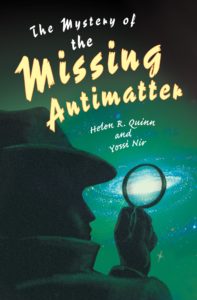 Image from Princeton university press
Image from Princeton university press
It’s published by Princeton university press, originally in 2008. Helen Quinn is professor emerita at SLAC whilst Yossi Nir is professor of physics at the Weizmann Institute of Science in Israel. His 2014 presentation 10+1 best reasons to like CP violation makes interesting reading. He had me with otherwise we would not be here. He goes on to talk about the three necessary Sakharov conditions, and says it’s a window to the early universe that proves the standard model wrong. You don’t hear that sort of thing every day. His seventh and eight reasons are QCD is CP invariant, and QCD is not CP invariant. I liked his last reason too: the joy of science.
A galaxy-sized twist
As for what happened in the early universe, I don’t know. It isn’t like particle physics where we can measure the deuteron magnetic moment. The evidence is thin, there’s much more inference, and there’s a temptation to retrofit. But I couldn’t help noticing that electromagnetism features in the Brookhaven RHIC article perfect liquid hot enough to be quark soup. It’s talking about a quark-gluon plasma or QGP, which “filled the universe a few microseconds after it came into existence 13.7 billion years ago”. The article says such a perfect liquid doesn’t fit with the usual picture of free quarks and gluons. I’d agree with that, and then some. In fact I’d say it’s something like pea soup, the point being that there are no actual peas in pea soup. In similar vein there are no actual quarks in a quark-gluon plasma. There are no actual gluons either, because the gluons in ordinary hadrons are virtual. As in not real. As in do not exist. The article also includes a video showing heavy ions with a spinor-like rotation, a glancing collision that sets up a dipole magnetic field, then vortices and charged-particle separation. Great stuff. It finishes with a picture of a spiral galaxy, which of course has a whirlpool aspect. It’s a shame about the multicoloured billiard balls, but never mind. The narrator says “this asymmetry at RHIC may help scientists understand a similar violation of symmetry in the early universe that resulted in the predominance of matter over antimatter in our world”.
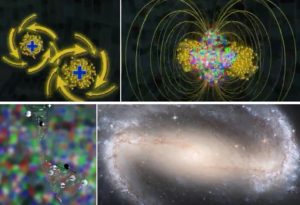 Still from the Brookhaven National Laboratory
Still from the Brookhaven National Laboratory
All this is familiar territory if you’ve read Maxwell’s theory of molecular vortices. Heaviside didn’t develop gravitomagnetism as an analogy of electromagnetism for nothing. Like the gravitomagnetic field, the electromagnetic field has a frame-dragged vorticial or “screw” nature, but much fiercer. Plus it sits rather well with another RHIC article scientists see ripples of a particle-separating wave in primordial plasma. Note the quote from Gang Wang: “this ‘chiral separation’ acts like a seed that, in turn, causes particles with different charges to separate. That triggers even more chiral separation, and more charge separation, and so on”. A seed sounds interesting. After all, from little acorns do mighty oak trees grow. Especially since on a grander scale there’s galaxy sized twist in time pulls violating particles back into line. That’s a Warwick university news article featuring Mark Hadley. He’s suggesting that the rotation of our galaxy results in frame-dragging, and that this causes a difference in the decay of matter and antimatter versions of the kaon and other particles. The related paper is the asymmetric Kerr metric as a source of CP violation. Interesting stuff.
A universe sized twist?
Especially since on an even grander scale there’s articles such as Left-handed cosmic magnetic field could explain missing antimatter. It dates from 2015 and features work by Tanmay Vachaspati and others. It talks about the discovery of a left-handed magnetic field that pervades the universe, wherein “the entire universe is filled with helical (screw-like) magnetic fields”. In electromagnetism the word rot is short for rotor, because the screw nature of electromagnetism is all about twist and turn and things going around and around. Not just electrons in solenoids and electric motors. Things like the Poynting-vector energy flow within the spin-½ “spinor” electron. Electrons spin, protons spin, the Earth spins. The Sun spins, neutron stars spin, galaxies spin. Particles and antiparticles might be equal and opposite, but they are spinors. They are themselves vortices, with a real rotation. An intrinsic rotation that makes them what they are, like a tornado’s rotation makes it what it is. In a rotating environment, where there’s frame dragging and a space-time vortex, space is twisted. Then the motion and behaviour of those particles and antiparticles is no longer equal and opposite. And get this: if you were moving through a region of twisted space but didn’t know you were moving, you might think you were situated within a turning region. Since space is a continuum, there are no freewheeling discontinuous regions of space within space. So you won’t be finding any magnetic monopoles any time soon. The only way space can turn is if it somehow all turns. So did the early universe spin like the ultimate magnetic monopole? I cannot rule it out, and I note that the electron magnetic moment is −9284.764 × 10−27 J⋅T−1 whilst the proton magnetic moment is a mere 14.10606 × 10−27 J⋅T−1. The spin is going the other way around a much smaller radius, and the angular momenta are not equal and opposite.
Twisters pop up in weird big bang soup
On top of that I have to point out that there has to be more to CP violation than unequal decay rates. lf pair production and annihilation were the only way to create and destroy our particles and antiparticles, we would always have the same number of each. You have to be able to destroy a particle without using an antiparticle. Is there such a way? Yes. You can “melt” a particle in your quark-gluon plasma. Google on melt and quark-gluon plasma. See articles like twisters form in big bang soup:
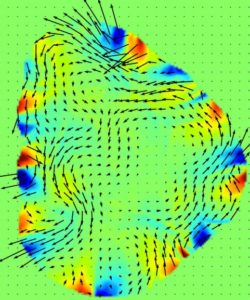 Image credit Berkeley Lab, see Twisters Pop Up in Weird ‘Big Bang’ Soup
Image credit Berkeley Lab, see Twisters Pop Up in Weird ‘Big Bang’ Soup
The article says scientists study this QGP in particle accelerators, where nuclei moving at near light speed collide, sending temperatures skyrocketing to trillions of degrees. It says the protons and neutrons then melt, and that the “soup” produces structures “shaped like rings and vortices”. See this quote which refers to Xin-Nian Wang: “Wang’s calculations show that the fluidic plasma in the vortices should generate lots of short-lived particles, called lambda baryons, with spins in the same ‘direction’ (either ‘up’ or ‘down’)”. Who’s to say it doesn’t create some long-lived particles too? Or if you then have charged particles moving in different directions, any directed back into the QGP will be melted and destroyed. That’s CP violation in spades. And for a bonus ball, some liken a quark-gluon plasma to a Bose-Einstein condensate, and some liken a Bose-Einstein condensate to a black hole. Yes, there’s another way to destroy a particle: drop it into a black hole. You can find some articles that say black holes do not destroy matter, but I’m confident that they do. I’m also confident that you can effectively break an electron like you can break a spinning disk. Parts fly off in different directions, and angular momentum appears to have vanished. I’m confident this can happen to protons too, which brings me back to something else about those electrons and those protons with their mismatched angular momentum: there’s an awful lot of hydrogen in the universe.
Baryon asymmetry and lepton asymmetry
In terms of mass, circa 74% of normal matter is hydrogen. There’s an awful lot of helium too, circa 23%. Check out big bang nucleosynthesis. Apart from a trace of lithium it would seem that other elements were made later in stars. See periodictable.com for a chart. Oxygen makes up circa 1% of normal matter, carbon circa 0.5%, iron circa 0.1%, and so on. Hydrogen is primarily made up of electrons and protons, whilst helium and the heavier elements are made up of electrons and protons and neutrons. If the neutrons were free, they’d undergo beta decay and turn into electrons and protons and neutrinos. Let’s simplify matters by setting the neutrons and neutrinos and antineutrinos aside, and say that in some respect matter is made up of electrons and protons. Can you hear the dog barking in the night? I can’t either. There does not appear to be a surplus of electrons as opposed to protons, or vice versa. There’s baryon asymmetry, where we see lots of protons but hardly any antiprotons, but there’s also lepton asymmetry where we see lots of electrons but hardly any positrons. And they match. How can CP violation explain that? Wilfried Buchmüller tries to explain it on scholarpedia and elsewhere. But he relies on heavy Majorana neutrinos and “sphalerons” and inflation, all of which remain hypothetical. I am not convinced that sphalerons convert antiprotons into electrons, conserving the B-L difference between the baryon number and the lepton number. In this universe, that difference is zero, and I do not believe in coincidences. I do however believe in going back over everything with a fine tooth comb looking for clues. Is there something we’ve missed? Something we’ve taken for granted? I think there is. This: “there is good evidence that the universe is mostly made up of matter and no antimatter”.
Positronium is an exotic atom
When you have eliminated the impossible, whatever remains, however improbable, must be the truth. Take a look at positronium. It’s “a system consisting of an electron and its anti-particle, a positron, bound together into an exotic atom”. The electron is matter, and the positron is antimatter. Positronium however is neither matter nor antimatter. It’s both. It’s an exotic atom. Now see page 314 of photon and electron collisions with atoms and molecules edited by Philip Burke and Charles Joachain. It says “the positronium atom thus created is in essence a very light hydrogen atom”. So positronium is both matter and antimatter, and it’s like light hydrogen. Now that’s interesting. To appreciate just how interesting, let’s play a little spreadsheet game. I draw a 2 x 2 table and put electron in one of the cells. Then you put positron into another cell, like this:
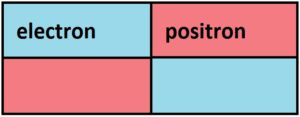
Now I have to put proton into the spreadsheet. I shall do this based on particle properties alone. It isn’t much like the electron, and it isn’t much like the positron either. But since it’s positively charged like the positron, the proton is more like the positron than it’s like the electron. So I’ll put it under the positron. That leaves only one cell free, so you have to put antiproton under the electron.
Antimatter is so labelled only by convention
There’s something I forgot to mention, and it’s this: there’s an ambiguity when it comes to matter and antimatter. If we have four particles a b c d we could label two of them matter and two of them antimatter. Let’s say a and b are matter and c and d are antimatter. We can then pair up those four particles in six different various ways: ab ac ad bc bd and cd. If we could somehow stick the two matter particles a and b together we could reasonably call the result “matter”. There’s only one way out of six that we could do this: ab. If we could somehow stick the two antimatter particles together we could reasonably call the result “antimatter”. There’s only one way out of six that we can do this: cd. However the other four combinations ac ad bc bd consist of both matter and antimatter. So there’s twice as many ways to make an exotic atom as there are to make an atom of matter or antimatter. The mystery of the missing antimatter is that there’s more particles than antiparticles in the universe. But if we took a tip from positronium and said hydrogen was an exotic atom too, we’d have the same number of particles and antiparticles in our universe. It’s time to put some headings on that spreadsheet:
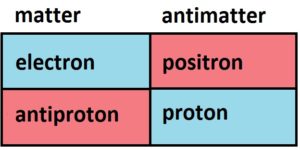
Hydrogen, which consists of an electron and a proton, isn’t matter or antimatter. Like positronium, it’s both. Something else that’s both is the neutron, which consists of an electron plus a proton with an antineutrino twist. It’s similar for antihydrogen, which consists of an antiproton and a positron. And for the antineutron, which consists of an antiproton and a positron with a neutrino twist. It’s both too. And yet they call it antimatter. Antimatter is so labelled only by convention. A convention that forgets that the particles are matter or antimatter, and that four out of six combinations are both. A convention that forgets that the neutron can’t just be matter if it decays by spitting out an antimatter antineutrino and splitting into two matter particles. Understand this, and the mystery of the missing antimatter looks rather different.
Mixed doubles
I am reminded of the old Chinese game of Go. Let’s say that “eyes” are not allowed, and I that play with blue counters whilst you play with red counters. If I win, the board is full of blue counters. If you win, the board is full of red counters. Either way we’d call it matter, and either way, one of us is going to win. I’ve never drawn a game of Go in my life. I’ve never drawn a game of tennis either. Tennis has tie-breakers, not draws. It doesn’t matter how evenly matched the players are, one side is always going to win in the end. In our universe, the blue team won. The losing side was the red team. Because the game they played wasn’t like just any game of tennis. It was like mixed doubles. Unfortunately the mystery of the missing antimatter rather suggests that the men won, and then asks what happened to all the women? Even though electrons and protons are attracted to one another, like men and women are attracted to one another. They form a stable bond, and we call it a hydrogen atom. Sometimes it’s a very close bond, and then we call it a neutron. Such a bond is stable in the right environment, such as in an atomic nucleus or a neutron star. It’s similar for positrons and antiprotons. Yes, electrons are also attracted to positrons, but that’s a fatal attraction. It tends to end badly. Ditto for protons and antiprotons. They annihilate too.
Playing the game
Like I said, I don’t know what happened in the early universe, but I do know that biology offers some interesting analogies. Some say circularly polarised radiation may have caused the selective destruction of one chirality of amino acids. That’s interesting because antimatter causes a Faraday rotation that goes the other way, and there’s such a thing as induced beta decay. Intense electromagnetic fields have been mentioned, as have photons, see photobeta decay. Something else that’s interesting is the idea that the early universe started out like a black hole, and somehow evolved like a time-reversed stellar collapse. Yes, there’s pair production and annihilation, but there’s pressure too, a great deal of pressure. Is it hot? I suppose it is, but the “coordinate” speed of light is very low, so it isn’t quite like the inside of a star. Perhaps it’s more like a neutron star, and an antineutron star too. There may be protons and electrons and electron capture, and therefore neutrons. There may be antiprotons and positrons and positron capture, and therefore antineutrons. Perhaps it’s something like a crucible, one where charged particles are swept to the left or right and back down to a place where they are destroyed. Perhaps only neutral particles can make it to the surface. Perhaps there’s a rotation such that antineutrons don’t make it either. Or perhaps there’s some kind of seeding the mix like Gang Wang’s chiral separation. A seed is the ultimate butterfly effect, the ultimate for want of a nail. Perhaps one small chance event gave an advantage to the blue team. As in a battle, an advantage can be magnified. Then the chances of survival for members of the losing team start to diminish, which tips the odds further. Before you know it you’ve got a stability tip, and it’s game set and match.
Where has all the antimatter gone?
I don’t know why the blue team won, but I think we’ll find out one day, and then the answer will be obvious. Meanwhile I think there’s a lesson to learn: there can only be one winner, and either way, two opposite chiralities survive. There was a winner because like Yossi Nir said otherwise we would not be here. So here we are, and we don’t find right-handed amino acids where we live. Or left-handed sugars, and we don’t wonder about the mystery of the missing anti-sugar. Because we know the difference is merely chirality. What’s the difference between the electron and the positron? Chirality, nothing else. That’s the difference between matter and antimatter. The electron and the proton have the opposite chirality. So hydrogen is a combination of matter and antimatter. We say the electron is matter, and the proton too. But we ought to say the proton is the antimatter. Then since the proton is 1836 times heavier than the electron, antimatter is a lot more common than you might think. Weight for weight, and pound for pound, 99.95% of everything around you is made of antimatter. Where’s all the antimatter gone? Nowhere. Because it’s hiding in plain sight. Because truth be told and by and large, you are made of it.
As you say, one team had to win, but maybe there is no absolute sense of chirality, just like the old philosophical question “how can you be sure my blue is the same as your blue?”.
So another way to define anti-matter could be as ‘the losing team’, and matter as ‘the winning team’. Then asking why there is more matter than anti-matter becomes as silly as asking “why didn’t the losing team win?”
I love it Jonathan! Why didn’t the losing team win? That’s really got a ring to it. Good man! But I’m afraid some people, who have been peddling the mystery of the missing antimatter for thirty years, won’t be too chuffed about that!
John Duffield aka “Farsight” wrote above :
.
” Because we know the difference is merely chirality. What’s the difference between the electron and the positron? Chirality, nothing else. That’s the difference between matter and antimatter. The electron and the proton have the opposite chirality. So hydrogen is a combination of matter and antimatter. We say the electron is matter, and the proton too. But we ought to say the proton is the antimatter. Then since the proton is 1836 times heavier than the electron, antimatter is a lot more common than you might think. Weight for weight, and pound for pound, 99.95% of everything around you is made of antimatter. Where’s all the antimatter gone? Nowhere. Because it’s hiding in plain sight. Because truth be told and by and large, you are made of it.”
.
OK, John. You solved one mystery. Perhaps you could try to solve two more?
.
1. The mystery of the missing anti-protons.
.
2. The mystery of the missing anti-hydrogen atoms.
.
.
.
John Duffield aka “Farsight” wrote above :
.
” And then there’s the CERN courier article does antimatter fall up? No it does not. Antimatter does not fall up
Anybody who knows anything about relativity knows why antimatter doesn’t fall up. It’s because the mass of a body is a measure of its energy content, as per Einstein’s E=mc² paper. ”
.
Dear John, to be so sure as to unconditionally say that anti-hydrogen atoms do not anti-gravitate, you would have had to perform an experiment first. There are 3 such experiments in the making at CERN. Why not just one? Because one experiment is not enough?
.
My question for you is as follows : Is the energy of an electron’s electric charge negative ?
.
We have positive and negative electric charges, so it would seem to me that proton has positive energy, and electron has negative energy, because both particles have electric energy field around them, but the lines of proton’s positive electric energy field point outward, and therefore the lines of electron’s negative electric energy field must point inward.
.
By analogy, the lines of positive mass/energy of atoms of matter gravitational field point inward, toward the center of mass, while the lines of negative mass/energy of atoms of anti-matter anti-gravitational field will point outward, away from the center of negative mass.
.
John, according to my hypothesis, in physical reality, even though energy can only have positive values, the lines of any field of energy naturally have two possible opposing directions.
.
So, just because anti-matter’s mass/energy has positive value, it does not follow that the lines of gravity field produced by antimatter have to have the same inward direction, like in case of normal matter.
.
Before you disagree with me, tell me what exactly is the factor responsible for electric energy field lines of electron being directed inward, toward the center of electron, as opposed to proton?
.
Hydrogen is an atom of matter, but anti-hydrogen is an atom of anti-matter.
To insist that anti-matter could not possibly have gravitational field with its lines directed outward, is akin to insisting that both kinds of electric charges must have lines of their electric fields directed in the same direction, because negative energy is impossible.
.
Is chirality the only difference between positive and negative electric charges?
.
Dear John, I hope that you will debate me in a scientific manner.
.
.
The link at “mystery of the missing antimatter solved by the magnetic field that spans the cosmos?” Is broken.
In any case, this blog post has been quite the journey. I would NOT be surprised if the asymmetry is due to an overall rotation of the universe. We have convincing evidence of this in the CMB (the “axis of evil” dipole) and in galaxy rotation distribution, and it would also explain the ultimate origin of angular momentum, and why there seems to be a cosmic magnetic field permeating space.
If matter really has its origin in spinning waves, it also clears up why one rotation direction (one chirality) is favored over another in the whole observable universe. Galactic frame dragging can’t be the only source of asymmetry, otherwise galaxies spinning in different directions would be able to produce a surplus of antimatter and we would see that in galactic collisions.
Electrons are the most common and most stable elementary “particle” because they form with the same intrinsic chirality of space itself (which in turn stems from the overall “rotation”). This in turn seeds other structure formation like protons due to the opposing charge, which becomes more important than having the “right” chirality. It would be interesting to see the rate of formation of antiprotons compared to protons in the absence of electrons, if such an experiment is possible.
Ah link rot, the bane of my life. Thanks Sandra, I have replaced the link with a similar article. Whilst I’m confident that matter is comprised of electromagnetic waves in a closed path, I’m not confident that a macroscopic rotation is responsible for “the mystery of the missing antimatter”. That’s because I think protons are antimatter, so the antimatter isn’t really missing at all. Instead it’s hiding in plain sight. In addition, maybe the protons do the seeding, not the electrons, and if so maybe it happened before there were any galaxies. It would be nice if the JWST could give a clue about that. I say that because I suspect it’s only going to be noticeable in a small dense universe, not the universe we live in now. I imagine that conservation of angular momentum would mean the rotation of the early universe would now be immensely diluted. But I don’t know that, and I would say this: early-universe cosmology is much more difficult than the easy stuff, like how gravity works, the nature of the electron, the nuclear force, et cetera.
.
PS: Sorry it’s taken me so long to reply.
There is still an asymmetry present even if we swap the definitions of antimatter around. Why are there more electrons than positrons? One had to win the game, the question is why. In chemistry and biology chiral structures seed other chiral structures, so I think it’s only natural to assume there was a chiral structure in the early universe that unbalanced the rates of formation. Whether the nature of this primordial chirality is an actual rotation is just my hypothesis. It could be a more complex type of movement like a toroidal smoke-ring, or something even weirder that I can’t imagine right now. But I bet it has to do also with the toroid-like revolutions of radiation inside particles.
I’d say the electron is almost guaranteed to be the one doing the seeding for the proton, because 1) it’s the lightest stable particle, hence requiring less energy to form, and 2) the topology is “simpler”.
I wouldn’t be surprised if you’re right, Sandra. As to gathering the evidence, that could be tricky. Are there any regions in space where pair production and annihilation is ongoing? Is there anything relevant in ultra deep field images? Are there any experiments we can do using magnetism? If not maybe computer simulations might help. One would start by modelling a photon, then pair production, then electrons and positron and protons and antiprotons, then annihilation and single-particle destruction, then a whole maelstrom. Then add rotation and see what happens. It would not be easy. Have you read https://physicsdetective.com/the-screw-nature-of-electromagnetism/ or https://physicsdetective.com/magnetic-monopoles/ ? IMHO a magnetic field is a “rotor” field, and the only possible magnetic monopole is the whole universe.
The point about labeling proton as “antimatter” is good, but really (like Sandra said) it just changes the question to electron vs positron dominated.
One point I think you should make is that electrons only annihilate positrons. but not anti-protons. That isn’t immediately obvious to people who have only heard superficially about this mystery.
As to why there is an asymmetry. Isn’t this what we would *expect* to observe, as long as there is some way to sequester/destroy half of a pair? Eg, say it is “sucked into a black hole”.
Then assume you have three types of events that happen after pair production:
1) No black hole around, the pair-self annihilates.
2) The “matter” half is lost to the black hole.
3) The “anti-matter” half is lost to the black hole.
Further, once the particle is out in the universe, it eventually encounters some preexisting particle. If it is same, then fine. But if it is matter vs anti-, then both annihilate.
This is like a series of coinflips. Call them heads/tails instead of matter/antimatter.
If given long enough time, eventually you will get a sequence like HHHHH (heads-dominated universe). Now generate a T, that will annihilate one of the H’s, right? So now its HHHH. Next step, there is 50% chance the next event is another H, so we are back to 5 H’s. But it could also be a T, in which case the universe “shrinks” to a size of 3 H.
Eventually so many T’s will be produced in a row it becomes “empty” universe, and from there even a tails-dominated universe.
Thus what we expect is cycling between (arbitrarily named) “matter” and “anti-matter” dominated universes, with very rare energy-only universes in between.
You can work it out using parallel particle production/destruction, a density-dependent delay between production/annihilation, and so on, but the basic outcome will be the same.
Seems this “mystery” is entirely reversed. It would be extremely surprising to live in a universe without a dominant type of matter.
It does make me wonder what an electron-antiproton dominated universe would look like though. Are you assuming that production/annihilation of baryons is independent of the same for leptons?
PS. It looks like maybe I can only add the non-breaking spaces between each paragraph *during an edit*. During the initial try got a Godaddy “exploit attempt denied by virtual patching”. Very nice game to get a properly formatted comment on here.
Sorry about the comment issue. I see the “game” as something like mixed doubles in tennis. One team will end up winning, and that team will be made up of a man and a woman. Matter and antimatter. Electrons and protons. Where did the antiprotons and the positrons matter go? I can’t say for sure, but I bet you could simulate it.
Maybe my comment ended up too long. The main point was there is no ultimate winner. There is a current leader, but no matter how big the lead, eventually you get enough minor (eg, “anti-“) particles produced in a row to annihilate all the dominant (“matter”) ones.
Mainstream theory (assuming pair production/annihilation + black holes) implies the universe cycles between proton-electron and antiproton-positron dominated states.
See here:
https://physics.stackexchange.com/questions/505662/why-is-matter-antimatter-asymmetry-surprising-if-asymmetry-can-be-generated-by
Malus: I will have to beg to differ on that. In my humble opinion the winning team won, that’s that, and here we are. The universe is not full of gamma photons along with ongoing pair production and annihilation plus particle destruction. I will however take a good look at your (?) Physics Stack exchange question and get back to you. Sorry ot be slow replying, I’ve been doing my latest article. I always go a bit quiet when I’m writing an article.
Fair enough. What is your estimate for the rates of pair production/annihilation and density of black holes (or whatever else) could act a sink for half the pair?
That is my question on the physics stackexchange, but its not problem to me if its wrong.
I will say that 10 blacks/reds in a row during roulette look surprising the first time, but not to “dealers” working there for even a day. Once you introduce “random chance” to a model, everything is guaranteed to happen given enough time.
Malus: I don’t have an estimate for the rates of pair production and annihilation. I’d say it’s fairly low nowadays, but was extremely high early on, when I imagine something akin to a “quark gluon plasma” acted as the sink. I think black holes can act as a sink too, see this article on gamma ray bursters: https://physicsdetective.com/firewall/. On top of that, I wonder if the early universe was a black hole. Stephen Hawking said that. However I am not a fan of Hawking radiation.
PS: I used to be an American roulette dealer. Me and my pal Nessie told the casino we were looking for adventure after university, and got jobs there. They trained us up, then three months later we left to start our proper jobs. No more bets please!